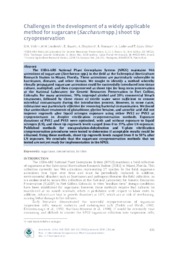Challenges in the development of a widely applicable method for sugarcane (Saccharum spp.) shoot tip cryopreservation.
Challenges in the development of a widely applicable method for sugarcane (Saccharum spp.) shoot tip cryopreservation.
Author(s): VOLK, G. M.; JENDEREK, M. M.; STAATS, E.; SHEPHERD, A.; BONNART, R.; LEDO, A. da S.; AYALA SILVA. T.
Summary: The USDA-ARS National Plant Germplasm System (NPGS) maintains 946 accessions of sugarcane (Saccharum spp.) in the field at the Subtropical Horticult sure Research Station in Miami, Florida. These accessions are particularly vulnerable to hurricanes, diseases and other threats. We sought to identify a method whereby clonally propagated sugarcane accessions could be successfully introduced into tissue culture, multiplied, and then cryopreserved as shoot tips for long-term preservation at he National Laboratory for Genetic Resources Preservation in For Collins, Colorado. For many accessions, 70% isopropyl alcohol and 20% commercial bleach treatments, followed by three rinses of sterile water weresufficient to remove microbial contaminants during the introduction process. However, in some cases, cefotaxime was particularly effective for removing bacterial contamination. We found that antioxidant treatments of glutathione, glycine betaine, and ascorbic acid did not improve regrowth after liquid nitrogen exposure usine either PVS2 or PVS3 as cryoprotectants in droplet vitrification cryopreservation methods. Exposure durations of PVS2 and PVS3 were optimized, with and without exposure to liquid nitrogen (LN), and shoot tip regrowth levels ranged from 0 to 37% after LN exposure. Published methods for encapsulation dehydration and V-plate vitrification cryopreservation procedures were tested to determine if acceptable results could be obtained. Using these methods, shoot tip regrowth levels ranged from 0 to 50% after LN exposure. We conclude that the sugarcane cryopreservation methods that we tested are not yet ready for implementation in the NPGS.
Publication year: 2019
Types of publication: Journal article
Keywords: Cana de Açúcar
Observation
Some of Embrapa's publications are published as ePub files. To read them, use or download one of the following free software options to your computer or mobile device. Android: Google Play Books; IOS: iBooks; Windows and Linux: Calibre.
Access other publications
Access the Agricultural Research Database (BDPA) to consult Embrapa's full library collection and records.
Visit Embrapa Bookstore to purchase books and other publications sold by Embrapa.

